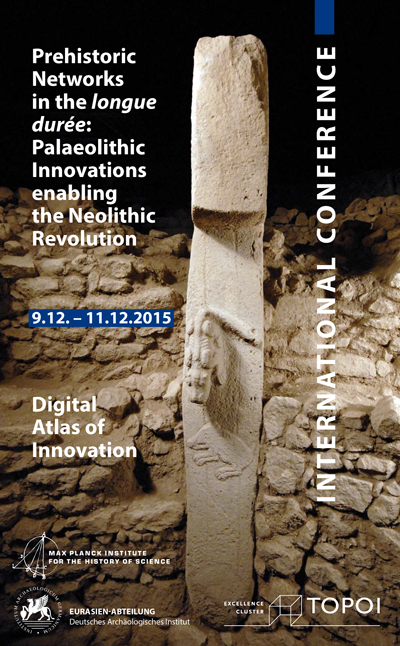 The conference will focus on the long-term development and diffusion of Prehistoric technology in the late Pleistocene and early Holocene. Two major fields will be tackled:
The conference will focus on the long-term development and diffusion of Prehistoric technology in the late Pleistocene and early Holocene. Two major fields will be tackled:
1. The relevance of Hunter/Gatherer-networks in the Palaeolithic and Mesolithic for the adaption and diffusion of key technologies enabling the Neolithic way of life.
2. The Impact the Neolithic Revolution had on long-distance networks, and whether these changed significantly or continued to exist.
The Neolithic Revolution has been seen as one of the most important shifts in the development of human technical systems. Yet, our understanding of this process is blurred by a lack of data concerning the extent and persistence of communication networks and their relevance for the conjuncture of key technologies. The conference brings together specialists researching the Late Palaeolithic, Epipalaeolithic, Mesolithic and Early Neolithic periods to discuss the role of networks for the transfer of prehistoric techniques. We want to focus on the long-term development and functioning of communication networks (gift-giving, raw-material procurement, marriage alliances etc.) in Late Palaeolithic and Neolithic societies. And building thereon, the impact of such networks on the tradition and diffusion of technical know how as a precondition for the shift we call Neolithic Revolution. While we might model localised autochthonous Neolithisation processes, the diffusion of the Neolithic stimulus is difficult to dismiss. On the contrary, we want to suggest a change of perspective and focus on the communication networks and question their relevance for the conjuncture of key technologies which might have triggered the Neolithic Revolution. Fernand Braudel’s concept of the longue durée will be applied systematically to the evolution of Late Pleistocene and Early Holocene societies, thereby focussing on the long-term development and functioning of communication networks and their impact on social, political and economical structures. Specifically we are interested in the following key questions:
• Which social mechanisms enabled societies to conserve and trade the knowledge of techniques necessary for the Neolithic way of life?
• What was the role of networks for the diffusion of Neolithic technology? Is it possible to trace these networks back into the Mesolithic and Palaeolithic?
• We would like to discuss the potential of Palaeolithic innovations. Is it possible to pinpoint the origin of the innovations enabling the Neolithic? Can we trace back trajectories that began long before the Neolithic?
• Which networks were able to bridge climatic and environmental boundaries? Is it possible to interpret the exchange of goods and ideas within networks as being set up intentionally or are these an unintended bi-product of the networks?
• How did networks change when more and more societies took over the Neolithic way of life? Were new technologies incorporated into existing networks or responsible for major changes in the long-distance communication?
Speakers
Hala Alarashi (Lyon): Pre-Pottery Neolithic Personal Adornments in the Northern Levant: Between Innovations and Inherited Traditions
Eleni Asouti (Liverpool): Woodland management before the Neolithic Revolution
Michael Baales (Olpe/Bochum): Palaeolithic networks and their importance for the Diffusion of Technical Know-how
Anna Belfer-Cohen / Nigel Goring-Morris (Jerusalem): The role of Networks for the Transfer of Technical Innovations in the Levantine Epi-Palaeolithic
Marion Benz (Freiburg) / Nicole Reifarth (Tübingen) / Elisabeth Völling (Würzburg): On the threshold – conflicting innovations and traditions during the early Holocene in northern Mesopotamia
Çiler Çilingiroğlu (İzmir): The Neolithic Package re-thought in the context of prehistoric networks
Sophie De Beaune (Lyon): A Technical Perspective on the Development of Palaeolithic Art
Güneş Duru (Istanbul): Social Innovations and their impact on Networks: The Emergence of Public and Private Spaces
Bill Finlayson (London/Amman) / Cheryl Makarewicz (Kiel): Communal, public and ritual: the built environment and the Neolithic transition
Birgit Gehlen (Köln): Grand scale Networks of the Mesolithic. The trapezoid blade industry
Fokke A. Gerritsen (Istanbul): The Initial Neolithisation of Northwest Anatolia
Nigel Goring-Morris / Anna Belfer-Cohen (Jerusalem): The Neolithisation in the Southern Levant
Gerd Graßhoff (Speaker of the Excellence Cluster TOPOI): Greetings and Introduction
Miriam Haidle (Frankfurt/Tübingen): Capacity building in the Palaeolithic, Performance in the Neolithic
Svend Hansen (Berlin): Neolithic figurines in the Near East
Harald Hauptmann (Heidelberg): The Sculpture from Nevali Çori and its wider Context
Barbara Helwing (Lyon): Metal objects in the PPN
Necmi Karul (Istanbul): Early Neolithic Settlements in the Tigris Region
Florian Klimscha (Berlin): Why should Societies become Neolithic?
Dietmar Kurapkat (Berlin): Early Neolithic Special Buildings and Networks of Architectural Knowledge in Southwest Asia
Johannes Krause (Jena): Cooperation models of Neolithic Societies according to Archaeo-genetic Research
Ryszard F. Mazurowski (Warsaw): Tell Qaramel within the Networks of the PPN
Ianir Milevski / Hamudi Khalaily (Jerusalem): The Plastered Skulls Cult and the Levantine Neolithic Social Fabric
Yutaka Miyake (Tsukuba): Innovative Techniques in the Early Neolithic site of Hasankeyf Hoyuk, Upper Tigris
Bernd Müller-Neuhof (Berlin): Conflicts as Constituents of the Neolithization
Mihriban Özbaşaran (Istanbul): Aşıklı Hüyük and its role in PPN-Networks
Mehmet Özdogan (Istanbul): Early Neolithic Monuments: Göbekli Tepe and Beyond
Joris Peters (München): The Domestication of Animals as a long-term process
Henny Piezonka (Berlin): Late Palaeolithic Hunter-Gatherer Networks in Eurasia
Jürgen Renn (Berlin): The Neolithisation as a longue durée-Niche Construction Process
Danny Rosenberg (Haifa): Paved with stones: The evolution of ground stone tools in the late Epi-Palaeolithic and Early Neolithic of south-western Asia
Daniel Schyle (Köln): Tradition and Innovation in the Chipped Stone Industries of the Late and Epipaleolithic in Western Asia
Shinya Shoda (Nara / York): Different Narratives on Innovation Processes: the innovation of Early Pottery by Late Pleistocene and Early Holocene Societies in East Asia
Thomas Terberger (Hannover): Major and Minor Palaeolithic Innovations and their Impact on Hunter/Gatherer-societies
Trevor Watkins (Edinburgh): Was the Neolithic New? Extensive Networks of sharing and exchange from the African MSA to Neolithic southwest Asia
